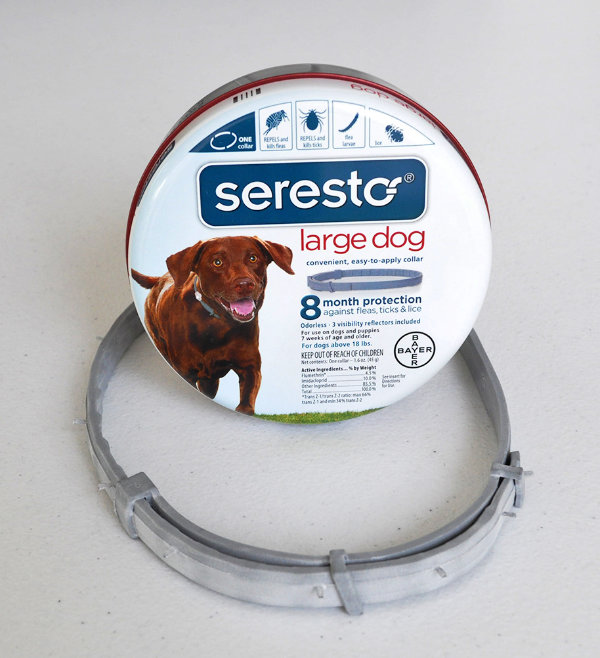On March 2, USA Today published an article about the Seresto collar, originally developed and brought to the market by Bayer Animal Health in 2012. The article highlighted the fact that the United States Environmental Protection Agency (EPA) has received nearly 1,700 reports of animal deaths associated with use of the collar. Worried pet owners have been flooding their veterinarians’ offices with calls about whether to remove their pets’ Seresto collars.
Dog owners should be aware that every effective pesticide will cause adverse effects in some animals; that’s the nature of products that are meant to kill parasites. But there are a number of things you can do to reduce the potential for harm to your dog:
- Don’t use any flea- and/or tick-killing or –repelling pesticides unless your dog needs that protection. If you are lucky enough to have never observed fleas in your home or on your dog, you may have no need for flea-control products; don’t buy them unless you need them! In some parts of the country, fleas and/or ticks are a fairly constant threat to pets and pesticides are needed to control and manage infestations. (I put the collars on my dogs when I am planning to hike with them in areas where ticks are numerous, or when my dogs get exposed to a dog with fleas. The rest of the year, they go without!)
- Use an integrated pest management (IPM) plan to control persistent flea infestations, so you can use pesticides less frequently in the future. This link provides a good source of information on how to do that.
- If the pets in your home repeatedly get infested with fleas, try to identify the source of reinfestations. Indoor/outdoor cats are often the culprits, as they may rest in places frequented by flea-infested mice, rats, squirrels, or chipmunks, picking up fleas there and inadvertently bringing them back home to reproduce.
- If you have used a particular flea/tick-control product and your dog had an adverse reaction to that product, note the information in any place that will help remind you to avoid that product or its active ingredients in the future. My granddog Cole had an adverse reaction to Frontline once, vomiting once or twice on the day after the spot-on was applied and exhibiting diarrhea for a day or two after that. About a year later, my son, misremembering which product had caused the adverse response, inadvertently used Frontline on Cole again (after getting fleas from a visit to a friend’s infested home), with the same response. Aghast, he called me to confirm that Frontline was the culprit. Now we both remember, and avoid that product for Cole.
- It’s easy to respond if your dog, like Cole, has an acute adverse response to a particular pesticide. (In the case of an adverse response to a spot-on pesticide, you can give your dog a series of baths to help eliminate all of the pesticide that was not yet absorbed into his skin. If your dog has an adverse response after you have put a Seresto collar on him, remove the collar and bathe him well.) But if your dog has chronic health problems, you may need to more deliberately consider whether any of the topical or oral pesticides you have administered to him may be connected to his health problems. We wouldn’t recommend giving dogs with cancer or those who suffer from seizures any pesticides whatsoever. Instead, we’d use whatever IPM tactics were at our disposal to control fleas if necessary, and would avoid tick habitats at all costs.
- If you have used a particular pesticide product on your dog with great success (fleas disappeared, walks in areas known to be infested with ticks did not result in any or just a few tick-attachments) and without any adverse events, stick to that pesticide if you need one in the future. Don’t introduce an entirely new pesticide that may pose potential side effects for your dog without a solid reason to do so.

That last tip is why I’m not going to stop using Seresto and start using some new product. Neither of my dogs has had an adverse response of any kind to the collars. If either one had, I would avoid that product, but I’m not going to expose them to a new pesticide; I have evidence that Seresto is not causing them harm, but I’d be starting from scratch with a new pesticide.
It’s easy to forget what life was like before we had effective, relatively safe, long-lasting pesticides to kill fleas and ticks on our dogs. Many dogs suffered much more than their modern counterparts. Tick-borne diseases kill many dogs annually, and make many more suffer from chronic effects; without the measure of control offered by pesticides, these numbers would be much higher. Also, prior to the modern age of pesticides, it was very common to see dogs whose front teeth were worn to the gums from just chewing their own bodies in an effort to relieve the horrible itching caused by flea bites. While we would like people to use pesticides more sparingly and carefully, we wouldn’t like to go back to having none of these substances at our disposal.







I have had great success with diateamateous earth
The diatomaceous earth you need to use on your animal needs to be “human grade” and used with care. The stuff sold at Lowe’s is only for the garden & should not be used directly on any animal. That is my understanding.
You are absolutely CORRECT.. it MUST BE HUMAN GRADE!!
I have old dog care books that recommend sprinkling DDT on the dog’s bedding to control fleas!
You’re kidding! DDT is deadly for any living creature.
I don’t think you can even get DDT in the U.S. anymore. That’s what was killing our Bald Eagles, making the shells to fragil to hatch. Avoid it like the plague.
The article also mentioned, “Since Seresto flea and tick collars were introduced in 2012…… through June 2020, the agency has received more than 75,000 incident reports related to the collars, including nearly 1,000 involving human harm.
The incident reports include severe allergic reactions, etc. among both humans and dogs.
Nancy Kerns, you wrote, “That last tip is why I’m not going to stop using Seresto and start using some new product. Neither of my dogs has had an adverse response of any kind to the collars. If either one had, I would avoid that product, but I’m not going to expose them to a new pesticide; I have evidence that Seresto is not causing them harm, but I’d be starting from scratch with a new pesticide.”
Even though your dogs have not had an adverse response to the collars, how do you know the collars may not be having a long-term effect on them, resulting in a serious illness or cancer?
The article also mentioned the combination of the two pesticides in the Seresto collar are more toxic together than when used separately.
Personally, I will not take a risk with my pups using this or any other pesticide.
I totally agree with you CJ, I won’t use anything that could even “possibly” hurt my dog.
Lyme disease could kill your dog. That’s why people make this choice. Where I’m from, if I use NO tick control, my dog is going to get lyme disease. Period.
Nancy, when you talk about using the collar on an as needed basis, are you talking about using it consistently from one season to another? Or, are you putting the collar on only during hikes? I had used the collar for the full eight months last year with no apparent ill effects. I was under the impression it would not work unless it was worn consistently. We live in the Northeast and have a very bad tick problem. I initially used one of the oral tick medication for both our dogs. For some reason our hound/border collie mix gets way more ticks on her than our lab/pit mix. I started using the collars after a long walk in the woods where she got over 60 ticks on her in an hour. I live in an area where the deer population is quite high.
I would be very interested to find out if using the collar intermittently is effective. Or if that is not what you were doing
I use the chewable meds for my dog, but after a walk in the woods last fall where he had 8 ticks crawling on him when we got home, I asked my vet about using the collar to supplement the oral treatment. She said it was fine to add the collar when in tick infested areas and if I understood her correctly, it seemed like I should put it on the day before going into the woods, which wouldn’t necessarily work for me since our yard is sprayed for ticks, but they are in the woods where we frequently walk. I’m going to try adding it right before a hike and removing it when we get home to see if it still works.
When I use the collars intermittently, I use them for about a month to six weeks. When Otto developed a hot spot and, after flea-combing him for about an hour, I found a single flea on him, I bought new collars and put them on Otto and Woody, and left them on for about six weeks. Once I was sure that the pesticides had killed any flea Otto brought home, as well as any fleas that might have hatched from eggs laid by any flea that Otto brought home – a process that would take about six weeks to be certain – I took the collars off again.
In my preferred walking areas, there are no ticks. But when these places close to off-leash dogs (there is a nesting season which starts shortly and goes through the end of June) I will sometimes walk them in a more mountainous area where there ARE ticks. If I was planning to go there, I would put the collars on at least a few days before I actually went, and leave them on for at least a couple weeks.
I have the same question.
Very timely article. Given that fleas cause Hantavirus and Bubonic Plague, and areas are still affected by these diseases (there was a Hantavirus outbreak in the Lake Tahoe area last summer, and also a human death from Bubonic Plague in China suspected to be transmitted by fleas on a marmot), fleas are more than a nuisance. Lyme Disease causes chronic neurological syptoms in humans. Heartworm can seriously damage a dog’s heart. Many animals have a flea allergy, and even one flea bite causes severe distress.
I hike a few times a week with the dogs in the foothills and bringing home ticks isn’t desirable. I used to live in a high tick area (Butte Creek Canyon) pre Brevecto and used Zema dip, a 30 day residual dip, which worked well (so it was probably pretty lethal).
Since life has so many continuous risks, sometimes we have to choose based on what we dread more. In over 40 years of using pest control products on both dogs and cats, I have not yet had an adverse reaction. I just hope I continue to get lucky.
You forgot to include (I believe) counterfeit SERESTO Collars in your article.
Knock-offs can be toxic and hurt our pets.
MAKE SURE YOU GET YOUR COLLARS from reputable places and if you don’t spend at least $60 on the collar, it is most likely a fake!
You’re absolutely correct. And there is no way to know how many of the adverse effects experienced came from the counterfeits. Thanks for mentioning that.
YES, I ACCIDENTALLY BOUGHT FAKES FROM A SITE WITH SERESTO IN IT’S WEBSITE NAME. PAYPAL REFUNDED MY MONEY, AS I CALLED BAYER AND THEY CONFIRMED VIA UPC THAT IT WAS FAKE.
SOME TIME SAVING MONEY IS NOT SAVING MONEY – IT COULD BE HAZARDOUS AS THERE IS NO WAY TO KNOW THE INGREDIENTS, OR IT DOES NOTHING!!
DOROTHY
I have consistently used Seresto collars on my two Goldens with no ill effects. One the two has a bad reaction to topicals, so I never use those, ever. I have noted through some research that there are “ fake” less expensive supposedly Seresto Collars. Please check your container before putting this collar on your dog. Go to Seresto collars to see what to look for on the container!
My chiweenie has recently been diagnosed with mesothelomia and the vet cant figure out how it was contacted. I have dogs for over 30 yrs live in Massachusetts and never had this diagonis before. My dogs have been using Soresto for the past 5 yrs with good results and no reactions. Reading these new articles has me wondering if there is something on these collars that could cause this cancer. I have 3 dogs now who have used these collars but only 1 is sick. can you respond to this question PLEASE.
Im not going to use these this year until i find out more information
Thanks very much
Sincerely
Honestly, there is no way to know. Only when enough well-documents adverse effects reports are compiled that show a clear trend, could we know whether a specific type of cancer caused by the collars. Like us, dogs are individuals and there are many factors that contribute to cancer. It could be that your one dog had an inherited predisposition for cancer, or was exposed to something that the others were not exposed to.
Nancy – how do you feel about Capstar? I give my dog a combination of Credelio and Intercepter plus which covers heartworm, fleas and ticks. It seems to work fine. In our area in Seattle some summers that a kind of microflea shows up. I don’t know what it’s called and it’s only been a problem a couple times. I’ve been told that Capstar is safe to give your dog at any time. It kills the live fleas right away and if they are not in the house I give another dose two days later to kill any eggs that have hatched snd once again two days after that. It is supposed to be safe to give at the same time as any other medications. I’ve had good luck with it through three dogs now and always have a box of the tablets around. For dogs that react badly to flea bites, it’s a way to give immediate relief. Anyone else use it as a stop-gap measure for the occasional exposure? Also, we have mostly hardwood floors, but what do people use to rid the house of them? Flea bombs are out and it’s not feasible to shampoo a whole room of carpet.
Back in the old days, we would use Sevin dust, or mix it in water and bathe them with it. We live in rural Mississippi, so we have severe flea and tick problems, as well as moderate mosquito problems. We live on a hill, so there is not much standing water for them to breed. Ticks are our main issue. We spray the yard a couple of times in warm weather to keep them under control. Deer, raccoons, and semi-feral cats make sure we have an adequate supply of the little pests! We have been using NexGard when it is needed, with no ill effects at this time.
I’ve never used the collar but have heard of the bad reactions.
I use topical on my dog. Advantage Multi. I used Revolution on my previous dog but it didn’t work fast enough to keep the fleas from biting him before they died so I switched. The last year of his life I used nothing as he was 14 and seemed to have developed sensitivity to a lot of things and I wanted to minimize the chemicals in his body.
When the orals came out (and he was younger) I tried them once and he vomited so I have avoided orals. I have an objection to feeding my dog a systemic poison. I think of all of the flea preventatives I just sense that is the worse. And I don’t want to shorten my dog’s life for my convenience.
Every dog is different just as every human is different. Diana has no adverse reaction to the Advantage Multi so I’ll use that. It’s the only topical I can use that also prevents heartworm and I won’t feed her the heartworm poison pills.
I had a collie for 3 months. Her owner did not want her anymore She always wore these restos collars. She had a carcinoma nose. She bled for several Through her nose and mouth. of her
I will continue to use it as well. My dog had an allergic reaction to Nexgard and wound up in the ER. The Soesto works for my dog with no side effects. Thank you!
The diatomaceous earth you want to use is “Food Grade”, I purchase it in 50 lb bags. It is also useful for killing and the prevention of intestinal parasite. The amount depends on animal size. I find certain Cedar oils work well for short periods of time(sprayed on fir and rubbed in). I also use Cedar chip or shavings around the outside of my home and dog bedding. I find that with four shepherds and two cats, all indoor / outdoor (dog & cat doors) in GA, I am able to avoid all those toxins and fleas. I stopped using pesticides, after I all most lost one of my shepherds’ 10 years ago.
I agree with you. Very smart.. essential oils are a great deterrent. Cedarwood, citronella and oregano oils in a glycerin base. I use it on my dogs fur. I use the seresto collars and I do believe the counterfeit ones are the culprits of the sick dogs. There are ways to detect a counterfeit vs the real deal.
Just to check in from Europe I’ve been using Seresto for five years (he’s five) on my 25 lb Havanese with no ill effects thus far. Now I’m a bit worried if I’m slowly poisoning him. I buy mine from either the vet or a reputable website catering to pets where I buy his food. I pay 36 euros about $40 US for the larger size now that he’s outgrown the under ’10 kilos’ band. Why is it so expensive in the US? Any chance of posting a link to the article about Seresto?
For fleas I use a homemade Shampoo that works well on both dogs and cats. I mix and store it in milk jugs.
3oz glycerine (6 tablespoons)
3oz mild liquid detergent (6 tablespoons) I use Lemon Joy.
1.5oz white vinegar (3 tablespoons)
24.5oz water (3 cups + 1 tablespoon)
A few drops Pennyroyal or Eucalyptus to the mixture helps repel fleas. This recipe was published in a newspaper many years ago and it works well on my keeshonds. Collars , topicals don’t work with the heavy coat; they vomited oral chew doses back up.
Wash dogs, leave on soapy and as you rub them you will see dead fleas in the water.
you know that because these collars are expensive, there are many sellers selling fakes for cheap, and the packaging is identical to BAYER packaging. thus those dogs dying might be reacting to the counterfeit collars with unknow ingredients. Bayer will check the upc number on your collar’s package and tell you vendors that they supply – sometimes cheaper is not cheaper, you get either dangerous item or useless item
SINCE 2012 i’ve been using seresto on my many adopted – foster – unadoptables! most are 9lbs to 12 lbs. NO NEGATIVE REACTION TO SERESTO COLLARS, HOWEVER I DO CHECK TO SEE IF THERE IS A RASH, I DO NOT LET DOGS EAT EACH OTHER’S COLLARS. SO CARE IS NECESSARY. ONLY 1 COLLAR/8 MONTH’S PER DOG/ THE CORRECT WEIGHT RANGE.
DOROTHY
I too wondered if these collars that are killing dogs are fake Soresto. I read that the police confiscated a large truck full of collars not long ago in the U.S.
I bought a collar from a discount pet online store and my dog got strange lumps on her skin after putting it on. Now I buy mine directly from PetSmart. When I bought from the online store it was shipped from some Asian warehouse so I think that collar was fake. I have never had a problem with the Soresto collars before that one and my GSP continues to have good results with the one I got from Petsmart.
my 80 lb retired racing greyhound started having seizures after 4 doses of Simparica
( sarolaner) chewables! These were prescribed
by a Vet who thought it the best way to give
flea/tick medicine because the dose was measured. Later I learned that abnormal neuro symptoms may be caused while
using this stuff —it’s on the box. Now I’m
scared to give him flea prevention chemicals
When Seresto came to market, I purchased and then read the possible side effects, i returned it immediately. We had one dog die from a “safe for pets and children” and another with with an aggressive cancer that took him from diagnosis to death in 8 days. I am all for as few manufactured chemicals as possible. Question: does Brewer’s Yeast prevent fleas or ticks? I like the idea of the human grade diatomaceous powder.
Brewers Yeast can help with the repelling of fleas and ticks and so can food grade diatomaceous earth. I would look into a a product called Flea Free from a company in Florida. There product has worked for me for years. I used to give brewers yeast, food grade DE, garlic and use essential oils. For the past years i have using these products… food additive, shampoo, yard spray and even a body spray too.
Sometimes the damage or reaction is instant and sometimes the reaction can take a long time to build up. There are so many natural ways to ward off fleas and ticks here in the USA and i have never used any chemicals. Unfortunately my friends 2 dogs died from the collars and he started a fb page to make people aware of the danger. I would encourage anyone who has has issues or worse… a pets death to please look into joining the fb page, discussions and potential class action lawsuit against Bayer Elanco.
I use a natural liquid food additive called Flea Free from Natural Pet Products in Florida. It repels fleas, ticks, mosquitoes and mites. It is made in Florida, USA for the past 30 years with great success. Since Florida is a major bug state their whole line of products are well tested.
I believe my dog got bladder cancer from the Seresto Flea and Tick Collar. Bladder cancer caused by pesticides and the collar is the only pesticide she has ever been exposed to.
I have used soresto collar for years. I was duped a few years ago into buying the collar at a bargain price. When it didn’t work I realized it was fake. If you are not paying over $$40 dollars for the collar it is fake! It will not kill fleas!
This is good. Pest control is essential nowadays. Thank you for sharing this post, and looking forward to the latest one.
Hi All,
I use alternative Flea and Tick control like Bravecto for Dogs. And It’s recommended by my vet. Before this, I tried Seresto Flea and Tick Collars for my cat. It’s work awesome and i liked it. But my dog snatch it and never worn that is why I use alternative. this is very essential for furry friends. Thank you for sharing such an informative article with us. Great!
Nice post and very well written. My vet recommended me Flea and Tick Collars or chewable treatment. So, I choose chewable treatment for my dog. I never use this collars because I always doubted that kind of treatment. But after reading this post, my thoughts are cleared. Thank for sharing an informative post. Great job!